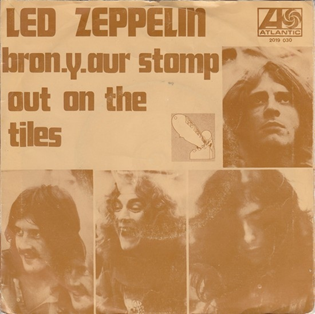Top Qs
Timeline
Chat
Perspective
Bron-Y-Aur Stomp
1970 song by Led Zeppelin From Wikipedia, the free encyclopedia
Remove ads
"Bron-Y-Aur Stomp" is a song recorded by English rock band Led Zeppelin for their third album, Led Zeppelin III, released in 1970.
Remove ads
Background
The title of the song is a misspelling of Bron-Yr-Aur by omission of the 'r' in yr, and takes its name from a house in Gwynedd, Wales, where the members of Led Zeppelin retreated in 1970 to write much of Led Zeppelin III after having completed a concert tour of North America.[5][6] Bron yr Aur means "hill of gold". Its pronunciation is [ˈbrɔn ər ˈaɪr]. The cottage had no electricity or running water, but the change of scenery provided inspiration for many of the songs on the album, including "Bron-Y-Aur Stomp".
Remove ads
Composition and recording
Jimmy Page and Robert Plant wrote "Bron-Y-Aur Stomp" in 1970. The song was heavily influenced by a number called "Waggoner's Lad" by Bert Jansch, a Scottish folk musician and founding member of the band Pentangle. It is a country music-inflected hoedown,[7] with lyrics about walking in the woods with Plant's blue-eyed Merle dog named Strider.[5] Plant reportedly named his dog after Aragorn (often called Strider) from J. R. R. Tolkien's The Lord of the Rings.[8] However, there are no explicit references to Tolkien works in "Bron-Y-Aur Stomp". In live performance, Robert often shouts "Strider!" at the end of the song.
The group recorded the song at Headley Grange in 1970, using the Rolling Stones Mobile Studio.[9] They completed it at Island Studios in London, and Ardent Studios in Memphis, Tennessee.[9] Guitarist Jimmy Page used an acoustic guitar, drummer John Bonham played spoons and castanets,[5] and bassist John Paul Jones played a double bass.[10]
Remove ads
Personnel
According to Jean-Michel Guesdon and Philippe Margotin:[1]
- Robert Plant – vocals
- Jimmy Page – acoustic guitars
- John Paul Jones – double bass
- John Bonham – drums, castanets, spoons
- Unidentified musicians – maracas, hand claps
Jennings Farm Blues
Led Zeppelin also recorded the song as an electric blues rock instrumental, "Jennings Farm Blues", a rough mix of which later surfaced as a studio out-take on a number of Led Zeppelin bootleg recordings.[5] Jennings Farm is the name of the property at Blakeshall on which the Plant family stayed in the early 1970s.[11] "Jennings Farm Blues" was released on 2 June 2014, as part of the remastering process of all nine albums.
Remove ads
See also
References
Bibliography
Wikiwand - on
Seamless Wikipedia browsing. On steroids.
Remove ads

